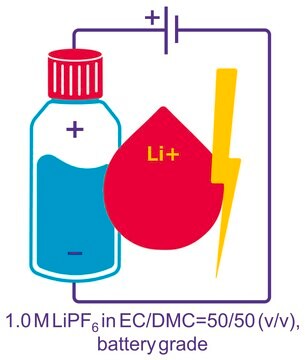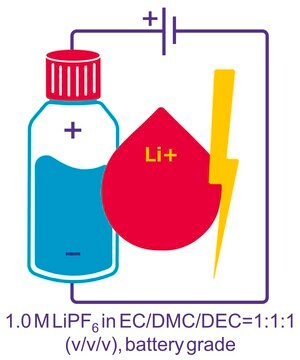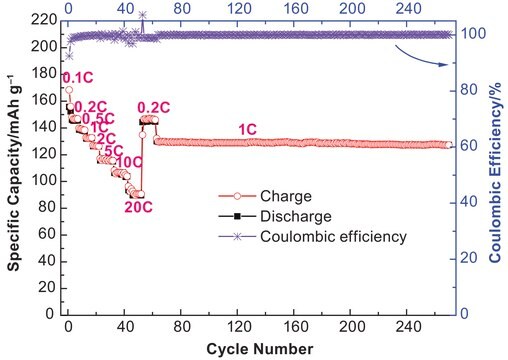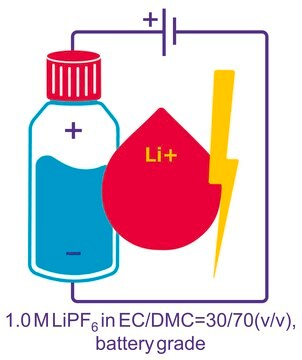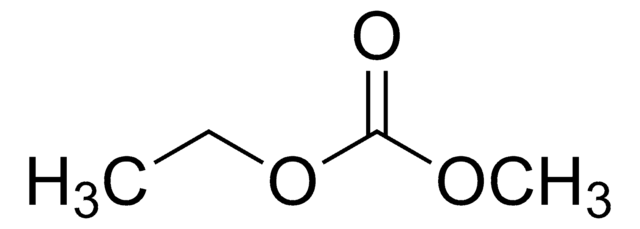推薦產品
等級
battery grade
品質等級
形狀
solution
環保替代產品特色
Design for Energy Efficiency
Learn more about the Principles of Green Chemistry.
sustainability
Greener Alternative Product
濃度
(1.0 M LiPF6 in EC/EMC)
雜質
<15 ppm H2O
<50 ppm HF
顏色
APHA: <50
bp
100 °C
密度
1.27 g/mL at 25 °C (lit.)
負離子痕跡
chloride (Cl-): ≤1 ppm
sulfate (SO42-): ≤2 ppm
正離子痕跡
Ca: ≤1 ppm
Fe: ≤1 ppm
K: ≤1 ppm
Na: ≤1 ppm
Pb: ≤1 ppm
應用
battery manufacturing
環保替代類別
SMILES 字串
F[P-](F)(F)(F)(F)F.[Li+]
InChI
1S/F6P.Li/c1-7(2,3,4,5)6;/q-1;+1
InChI 密鑰
AXPLOJNSKRXQPA-UHFFFAOYSA-N
尋找類似的產品? 前往 產品比較指南
相關類別
一般說明
應用
即用型电解质溶液有不同的溶剂混合物可供选择,可支持多种锂离子电池应用。这些溶液具有高纯度和电池级,因此也适合作为 LIB 研究的标准品。可通过混合电解质溶液或混合适当的添加剂来制备定制制剂。
其他說明
- 请勿与玻璃设备配合使用
- 所有工作都应在干燥空气下快速完成,以防止电解质的吸水和溶剂蒸发。
法律資訊
相關產品
訊號詞
Danger
危險分類
Acute Tox. 4 Oral - Eye Dam. 1 - Flam. Liq. 3 - Skin Corr. 1A - STOT RE 1 Inhalation - STOT RE 2 Oral
標靶器官
Bone,Teeth, Kidney
儲存類別代碼
3 - Flammable liquids
水污染物質分類(WGK)
WGK 2
閃點(°F)
86.0 °F
閃點(°C)
30 °C
客戶也查看了
文章
Dr. Sun reviews the recent advances in solid-state rechargeable batteries and cover the fundamentals of solid electrolytes in solid-state batteries, the theory of ion conduction, and the structures and electrochemical processes of solid-state Li batteries.
The critical technical challenges associated with the commercialization of electric vehicle batteries include cost, performance, abuse tolerance, and lifespan.
Lithium-ion batteries (LIBs) have been widely adopted as the most promising portable energy source in electronic devices because of their high working voltage, high energy density, and good cyclic performance.
Due to the adverse impact of the continued use of fossil fuels on the earth’s environment and climate, researchers have been asked to develop new approaches for producing power using renewable sources like wind and solar energy
Global Trade Item Number
| 庫存單位 | GTIN |
|---|---|
| 746738-100ML | 4061838070036 |
| 746738-500ML | 4061835435630 |
我們的科學家團隊在所有研究領域都有豐富的經驗,包括生命科學、材料科學、化學合成、色譜、分析等.
聯絡技術服務